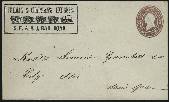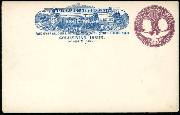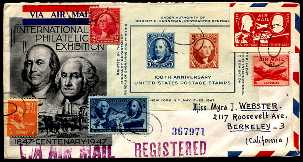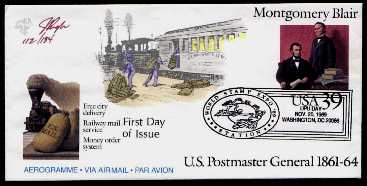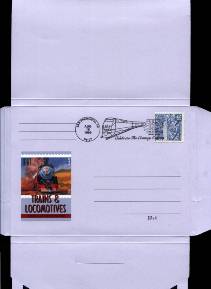
Click for Factbook article |
TRAINS on POSTAL STATIONERY
UNITED STATES OF AMERICA
|
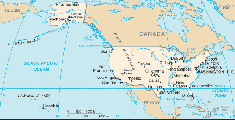
|
(click on any image for an enlarged view in a separate window.)
| Postal stationery is not popular with the public in the US, so there have been relatively few issues (only 640 through 1966), and few of those with a rail theme. Recently, though, the USPS has been issuing postal cards in conjunction with some of the historical commemoratives such as the Civil War and Famous Baseball Parks, and consequently the volume of listings has swelled. | |

Sc. U221 - issued 1876
|
3¢ CENTENNIAL STAMPED ENVELOPES - 1876Envelopes - 1876 - issued for the US Centennial The Scott catalog gives us few details about these envelopes, except that they were printed by Plimpton Manufacturing Co, (of Hartford, Conn.), and that there are four varieties: U218, with red indicium and a single line under "POSTAGE"; 219, green, also with a single line; 220, red, with a double line under "POSTAGE"; and 221, green, with double line. 218, 219, and 221 retail for about $50 each as cut squares, a little more as entires, while 220 is one of the scarcest and most valuable U.S. postal stationery items, with an italicized Scott catalog value of $30,000 as an entire! (The italics means there are few known examples, and the item trades seldom, so the price is somewhat a guess.) Most authorities believe it was a favor printing, and should not have reached private hands at all. We can deduce from the design and the date of issue that these were issued to commemorate the U.S. Centennial. I have always thought it odd there were no special postage stamps issued that year, but I also find it refreshing that they didn't think to exploit it that way. Yet they did issue this. And of course they did reprint all stamps issued up to that time for a special display at the Centennial Exhibition in Philadelphia that year. The USPS publicity for the release of U582 (see below) states that this 1876 envelope was released at the Centennial Exhibition, which would certainly have made sense, but I can find no other verification for that assertion. George B. Sloan wrote about this issue, in several of his columns in 1940, 1941, and 1954, that some of the envelopes were actually printed at the Exhibition, as part of the USPS display there. He also noted that the two colors were related to the two sizes in which the envelope was issued, the green being a "No. 3, full letter," and the red being "No. 4½, commercial." All the copies I have seen agree with that assertion, the green being 83x138mm, and the red 85x148. Furthermore, the double-line die - Scott U220 and 221 - was the one used at the Exhibition, and is called therefore the "Philadelphia Die", while the single-line die is the "Hartford Die." Since all printing at the Exhibition was supposedly in green, this supports the contention that U220 was never officialy issued. The train is a classic 4-4-0 steam locomotive with tender and mail car, and one of my favorites. Above it is a Post Rider, and the two images are perfectly appropriate. In 1776, pre-(or at least early-)Industrial Revolution, the Post Rider (or mounted mail carrier) was still the primary mover of mail between towns, with twenty-odd of them employed by Benjamin Franklin, recently appointed Postmaster General of the united colonies. By 1876 the train system was the backbone of the Nation, and the Railway Mail Service was well established, having been in existence twelve years, with 850 Railway Mail Clerks employed full time by the USPOD. (We know the car being pulled by the train is a mail car, by the way, not simply because of the context - old vs. new ways of carrying mail - but also by the letters "USM", for U S Mail, on the side of the car - you need a good copy to see them, but they are there.) This design was reissued (modified for the occasion, of course) in 1976, for the Bicentennial - more on that below.
Click here to visit a page about railroad travel to the Centennial Exhibition in
Phildelphia in 1876.
Here's a great item (bottom at left) - a Centennial stamped envelope used by a Western express carrier. This was offered in the Siegel Auction Galleries May 18, 2002 Rarities sale, with an estimated value of $1,000 to $1,500. Here's the auction catalog decription:
|
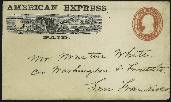 |
Envelopes - 1850 to 1900 - Truman & Chapman , American Express, Wells Fargo & Co.
One could debate whether these are valid postal stationery in the sense defined in the introduction to these pages, but they are popular among collectors, so we are including them here. The private franks on the left sides of the envelopes were added by the respective companies, either preprinted or in some cases handstamped. They represented payment of an additional fee (above the Post Office fee) for carriage of the envelope outside the US mails, either in areas where the USPOD did not carry mail, or where its service was slow or unreliable. There were many companies, large and small, that provided such services in the latter half of the nineteenth century, these are just representative examples. Truman & Chapman was short-lived California expresss company. I assume the American Express envelope is from the East Coast firm of the 1850-1860's. The Wells Fargo & Co Express used many different franks over the 66 years (1852-1918) it operated express mail service in the West, but only the three of them shown here had a train in the design. They differ in the date in the right-hand tablet: 1883, 1884, and 1892; and for the third, in the inscription beneath - COLUMBIAN ISSUE. Berthold (Wells, Fargo & Co.'s Handstamps and Franks, 1926) shows as well a "VICTORIA, VANCOUVER ISLAND" variety of the 1884 frank (quite rare), and two varieties of the 1892 envelope - one with small "1892" and one with large. The railroad scene in the WF frank shows a 4-4-0 with smoke stack shape characteristic of Central Pacific RR engines built in Sacramento, CA shops.
A little history: WELLS, FARGO & COMPANY'S EXPRESS (1852-1918) - Transcontinental private mail and package express company that was started on March 18, 1852 in New York by Henry Wells and William G. Fargo. The intended operating area of this express company was the California coast and gold fields and it began its express business in California later in 1852. Wells, Fargo & Co.'s Express quickly expanded throughout California and gradually acquired other express companies and railroad express contracts until it achieved true transcontinental coverage on March 16, 1888. It became one of the four largest U.S. express companies ever, and perhaps it alone was the biggest in U.S. history. The official business name was changed to Wells Fargo & Company Express in 1898. The U.S. package express business portion of this company subsequently ended and was absorbed by the American Railway Express Co. on July 1,1918 by federal proclamation. However, Wells Fargo continued with their express business in Mexico into the 1940's. The Wells Fargo banking operations that was started in the 19th century also continued to prosper after 1918 and this institution is still going strong today.(quoted from Bruce H. Mosher's Catalog of Private Express Labels and Stamps. Click here for more about this book.) |

|
Advertising cover with small train in design - The basic item here is a postal envelope, but the sender has added his private advertising design, so this does not qualify as rail philatelic postal stationery in the sense we defined in the Introduction to this list. I am including it just as a nice example of something that looks like it might belong, but does not. For a set of pages with a lot of similar material, CLICK HERE. |

Sc. UC17 - issued 5/21/47 |
5¢ POSTAGE STAMP CENTENARY
|

Essays - not issued |
Essays for postal stationery surcharge - 1958When postal rates were raised in 1958, no postal stationery with the new rates was ready. Existing stocks had to be surcharged (a fairly common practice at that time). One of the designs considered for that surcharge was the one shown at left, on three stationery items of the period. These just came to light recently, and were lots 2419-21 in the Siegel Auction Galleries 2002 Rarities sale of May 18, 2002. The auction descriptions follow.
|


|
Envelope, 1972 and 1978 (?) Bulk rate permit imprint (private) TG - Testing the railway bridge, Hartford Vermont, 1887.
Imperial Albums, Hartford, VT. Linn's Stamp News of September 7, 1998 carried an article by Michael Schreiber about this envelope. It read, in part, as follows:
|
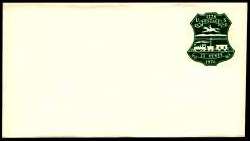
Sc. U582 - issued 10/15/76 (Printed on both #6 and #10 envelopes) |
13¢ BICENTENNIAL ENVELOPE
|

Sc. UC62 - issued 11/20/89 |
39¢ MONTGOMERY BLAIR AEROGRAMME - November 20, 1989This aerogramme was issued in conjunction with the 20th UPU Congress, in Washington, DC, an appropriate time and place to honor its subject, who played a key role in the creation of the UPU - some consider him its father. Appointed postmaster general by President Abraham Lincoln in 1861 he was responsible for major standardization of domestic postal rates and procedures, and such innovations as money orders, free city delivery, and the sorting of mail on railway cars. He was also commemorated on a 15 cent air mail stamp, Scott C66, in 1963. The Pugh FDC above has a cachet that is so subtly and ably executed that if one did not have the original item above for comparison, it would seem this is the way it was issued. The aerogramme was released at World Stamp Expo 89 in Washington. |

|
UX177 9/3/94 19c Union railway station, St. Louis, Missouri |


|
UX200 6/29/95 Civil War Heroes - 20c x 20 postal cards sold in shrink-wrapped packet
See UNITED STATES #2975a 2975a* 6/29/95 32c Steel clad steamships, "Monitor" & "Merrimack" (Virginia) in battle [Civil War Heroes issue historical information printed on back of stamp beneath gum] Note: The "Monitor" was designed & built for the North by John Ericsson, who also built the steam engine "Novelty" in 1829. |

|
ATA HB:
UC64 9/23/95 50c aerogramme on blue paper for foreign postage Thaddeus Sobieski Coulincourt Lowe (1832 1913), founder & builder of Mt. Lowe (California) cog Railroad (operated by Pacific Electric Railway through 1937) |


|
UX227 10/1/95 20c American Comic Strips Toonerville Trolley Folks; one of 20 different postal cards (#UX221/UX240) sold in shrink wrapped packet (same designs as UNITED STATES #3000) |

 ------------------------- |
8/26/99 'All Aboard!' - Honoring 20th Century American Luxury Passenger Trains
UX307 "Super Chief" UX311a Booklet of 20 "All Aboard!" cards, four each #UX307/11 |
 |
1999 USPS-issued unfranked (no indicium) USPS post card with "All Aboard!
Celebrate The Century Express" on picture side (the train was composed of an Amtrak P42
Genesis series diesel locomotive, a
baggage car, a modern exhibit car featuring Celebrate the Century commemorative stamps &
related
displays, a restored Railway Post Office [RPO] & an historic railroad business car).
Link to a page with more about the
CTCE, |
| Set of 21 unfranked USPS post cards (no indicium) issued during the trip of the CTCE, and picturing 20 US stamps showing trains, plus the CTCE. | |

|
UX373* Same image as UNITED STATES #3518 on postal card
3518* Trolley car in street at Shibe Park (later, Connie Mack Stadium), Philadelphia |
All maps courtesy of the CIA World Factbook.
All text Copyright © 2003, William M. Senkus
Send feedback to the webmaster: CLICK HERE
Revised -- 01/10/2015




